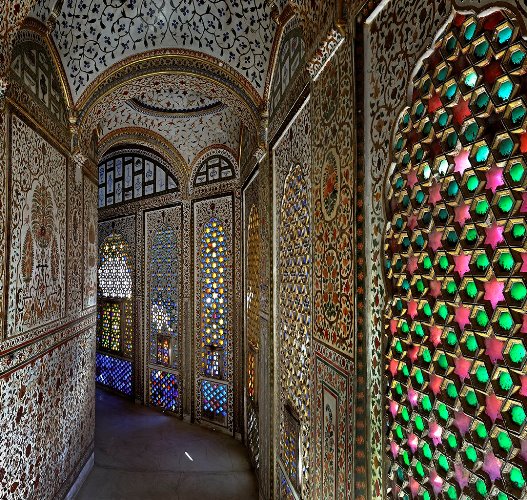Historical Background of The Craft :
Pachikaari Kala / Glass Inlay has its roots dating back to the Mughal period , evidence and theories reveal that Mughal patronage brought in craftsmen from far and wide who specialized in the mirror craft ,The Mughal royalty started using the mirror craft in their art forms. Mirrors were always considered a rich material which could be used to boast the royalty, riches and patronage ! It was not long when the glass started to shine in the eyes of the Rajput Rulers , they thought this material when used in such a way could depict their royalty better than most of the crafts ! Rulers of the Rajput dynasty all over started to use this craft of Pachikaari Kala in their palaces in different forms , sizes , purpose.
The art of inlaying hand cut pieces of mirrors using diamond scalpels into perfect shapes and arranged into frescos on the ceiling and the walls to form geometric mirrored mosaic patterns is known as “thikri” or mirror inlay or glass mosaic.
An old traditional artform from Rajasthan, where limestone, the base for thikri, abounds, thikri work makes for beautifying the walls, ceilings, niches of a house and even panels, tiles and furniture. This work can be seen in many of Rajasthan’s landmark palaces and heritage kothi’s, including the famous Amer Fort and Jaipur’s City Palace, where the ceilings, walls and niches in the Baradari café stands testimony to this heritage art form. 400

Ethnography of the craft making community :
Traditionally the community of Suthar ( Woodworkers ) and artisans of muslim communities started learning and practicing the art of glass inlay. It was not really restricted specifically to these communities but extended to other craftsmen communities and aspirants as well !
A traditional practice as a thriving business :
Traditionally this craft was largely used by royalty in their palaces to boast and depict their grandeur, with time this craft became a profession for many people , people like Mr. Rajesh excel in this craft and have devoted their time and expertise to revive this craft and take it to the height at which this is currently !
References in regional folklores , customs and rituals :
Mughal and Rajputi folklores have more references than any other ! The usual story was about the royalty loving the working and then mending it according to their own tastes and using them to depict their grandeur. Many modern day movies draw the reference of the “Sheesh Mahal” of the Rajputi Reign in their movies with reference to the work of Thikri to depict a storyline !
